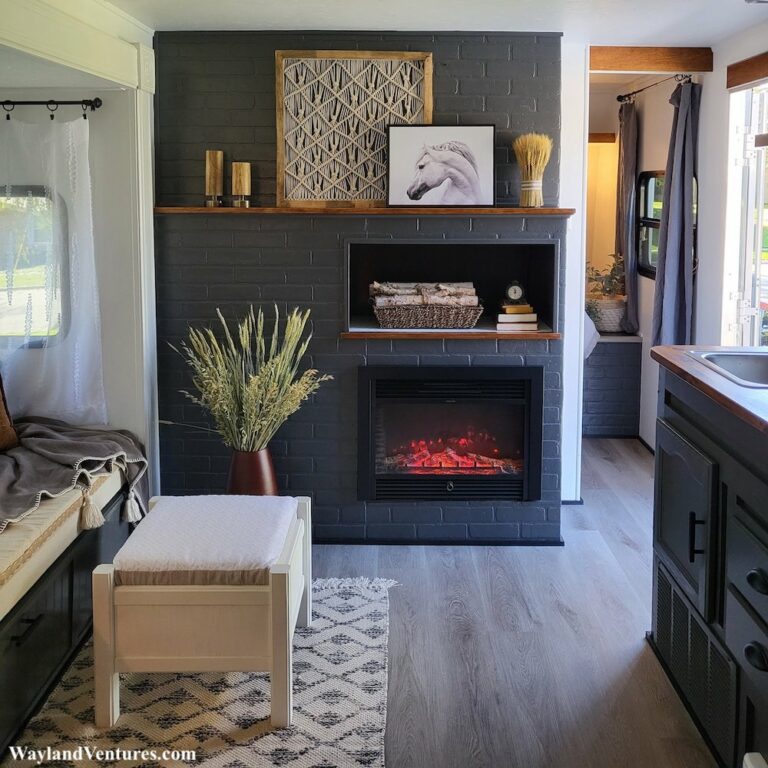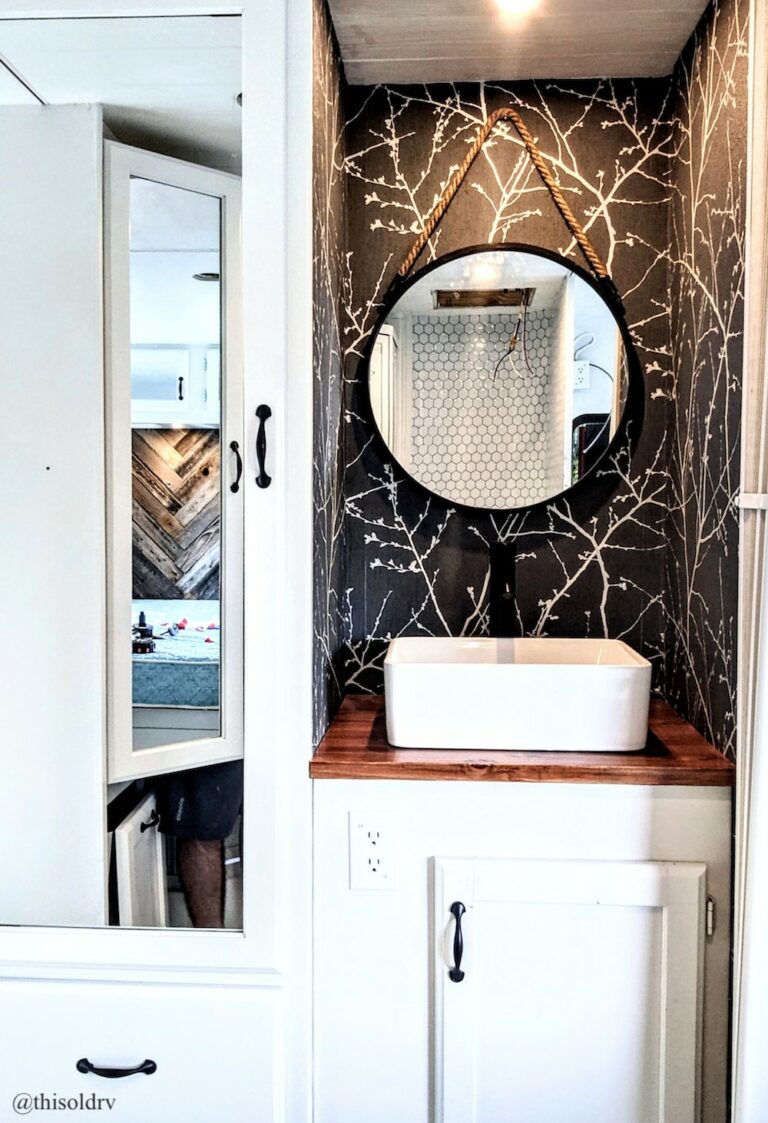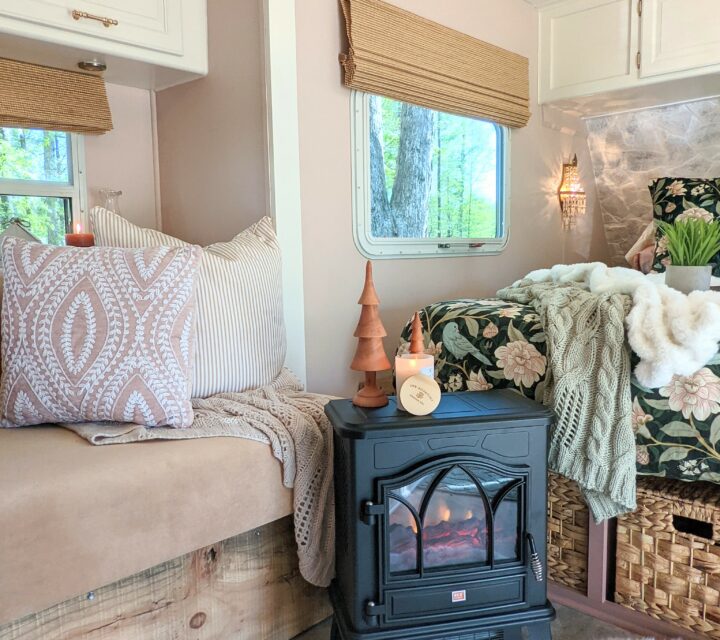12 Painting Mistakes Made by RV Owners (and How to Avoid Them)
This post may contain affiliate links.
Painting your RV walls and cabinets is an inexpensive way to transform your living space completely. But a few painting mistakes can quickly turn your shiny new space into a maintenance nightmare.
In this article, I share 12 common painting mistakes so you can paint your RV perfectly for the first time.
Related: A Complete Guide to Painting Your RV Walls
1. Inadequate surface prep
Surface prep is a time-consuming necessity—as much as you may want to skip it! Even though some products and paints promise you can skip it altogether, the best way to guarantee a great paint job is to prep your surface adequately. A little elbow grease now will save you from re-painting again in the future, costing you time and money!
One RV owner learned this lesson the hard way when she painted her laminate cabinets without priming. It wasn’t too much later that the paint started peeling off!

To avoid peeling, you must ensure the surface you’re painting has a texture the paint can “grab on” to. To oversimplify it, this is the purpose of primer. It is what your paint will grab onto.
The best method for creating a surface that paint will adhere to depends on what type of material you’re painting. This brings me to the next common painting mistake.
2. Using paint or primer that’s wrong for the surface
When I was young, I accidentally used interior latex paint on some exterior trim on our house. My dad told me it would need to be sanded and repainted, but I couldn’t see the problem. Sure enough, a few months later, the paint started cracking and flaking off. That experience taught me how important it is to use the right kind of paint for whatever project you’re doing.
Read Next: The Best Paint Brands for Painting RV Walls and Cabinets
Kilz is renowned in the RV world for having the best primer. You can use it on both your walls and your cabinets. For your RV interior, you will want an interior latex-based paint. There are multiple brands that RVers recommend that world well; just be sure to prime and paint separately.
3. Not reading the instructions for the products being used
One RV owner read that she wouldn’t have to sand her cabinets as long as she used a certain kind of paint. Skipping sanding is pretty appealing.
Unfortunately, the paint ended up peeling off her laminate (fake) wood cabinets. She ended up having to strip and sand it all off. More time, more elbow grease, and even more money!

Later, she discovered that the paint company’s website said to sand first! Lesson learned. While blogs and Facebook can be great resources for gathering information, they are no replacement for reading and following the product’s instructions! What worked for someone else, might not work on your RV. Always read the product instructions before you purchase.
4. Using cheap paint brushes
You can get a value pack of several paintbrushes for about the same price as one quality paintbrush. However, using a cheaper brush can result in brush strokes showing or bristles falling out and sticking to the paint. I like Purdy brand paintbrushes, but I know many people like Wooster brand as well.
- PURDY XL PAINT BRUSHES - Purdy XL Series brushes are great for all types of environments, both interior and exterior. These paint applicators will help you get the job done right the first time.
5. Planning to fix mistakes later
Some paint was on this trim piece when we were painting our RV walls. Oops, but no big deal. It was easy to scrape off, so we figured we would worry about it later.
A few months later (ha!) I finally got around to it, only to discover the paint wasn’t quite so easy to scratch off! It cured and is harder to remove. I still haven’t gotten around to it yet!

6. Not waiting long enough for the paint to cure
Paint scratches off easily the first few days after painting and becomes more durable after it cures for several days or weeks. Avoid doing anything that might scratch the paint, like moving in furniture, until the paint has cured.

If your paint does scratch within the first week or so, don’t despair! Give it at least a week before determining whether there is a problem with paint adhesion or if the paint was just scratched before curing.
7. Painting when it’s too cold, too hot, or too humid
Temperature and moisture affect primer and paint. After leaving on a space heater while the paint was drying, this RV came back to see this:

The paint had developed a splotchy appearance while drying. Another RV owner reported a similar experience when condensation built up on her RV walls while she painted with the heater running. Most paints recommend that you don’t apply in temperatures under 50º as it affects the paint. You may think that running a heater in winter would be fine, but the direct heat and condensation heaters cause can hurt the paint.
Fortunately, the residue in this photo disappeared after the RV owner wiped down the walls with a damp rag. Avoid problems by reading your paint can and finding the optimal temperature range and humidity level. You may need to run a dehumidifier while painting in some climates.
8. Using homemade chalk paint
Chalk paint is common in RVs. One RV owner I know decided to save money by making her own chalk paint using a recipe found online. She used homemade chalk paint successfully before when painting furniture, but it peeled off when she used it to paint her RV cabinets. She didn’t know exactly what caused the problem and had to sand it all off.
I’m not saying homemade chalk paint will never work. You might get lucky, and maybe you’re on a tight enough budget that the risk is worth it.
Using a highly recommended name brand can remove some of the risks and increase your chances of ending up with a result you love. Plus, you may get a refund if your name-brand paint has problems. I actually got a refund once on some spray paint that came out drippy and uneven.
9. Painting over seams that may shift during travel
I don’t consider this a painting mistake since I’m not sure it could have been anticipated, but it was a problem faced by RV owner Christina.
When painting her RV, she covered the seams between the cabinets and the wood trim. The first time Christina’s RV was moved after the cabinets were painted, the paint bubbled up as the RV shifted during transit.

To prevent this problem, score seams with a razor blade after the paint has dried and before the RV is moved.
10. Not testing colors first
I wanted light gray when I chose the paint color for my walls, but it looked white in the sunlight! I have a friend who bought paint named charcoal, but one coat revealed that it was blue, not grey!
Avoid this by purchasing a sample size of the paint first. Any paint store will do this for a couple of dollars. Paint a test area or paint a poster board and hold it under different lighting in your RV.
11. Waiting too long to remove painter’s tape.
If you remove the painter’s tape while the paint is still wet, you might accidentally smudge the paint. If you wait until it’s completely dry, the tape might peel the paint off! That’s what happened in the RV pictured below.

Remove tape while the paint is still tacky, but not completely liquid. The tape can easily break through the paint but won’t cause it to smear. If you notice that the paint is coming up with the tape, use a razor blade to score along the edge before you pull.
12. Trying to do it all in one coat
When you’ve bought a type of paint that was advertised as requiring only one coat, it can be frustrating to see the old wall color showing through. But that doesn’t mean you should just roll the paint on thicker.
A thick layer of paint or going back over painted areas before they are fully dry, can interfere with drying time. This can result in an uneven finish or leave visible brush strokes or marks from the paint roller.
Plan on two coats for anything you paint in your RV. (Even your RV shower!) Then, if you find you only need one, you will be pleasantly surprised!
Avoid These 12 RV Painting Mistakes
Anyone can paint, but it is easy to make painting mistakes, even if you’re a seasoned DIYer! Keep these 12 mistakes in mind as you prep, paint, and enjoy your beautiful RV.
Feeling bold? Paint your RV exterior!
Ashley Mann founded RVinspiration.com in 2017. She handed off the website to new owners in 2022 to launch a new business as an online entrepreneur coach, but she still helps out as the blog editor. Ashley spent three years living full time in a 38-foot, 5th-wheel RV with her husband Josiah and their cat, Kitty. Her favorite thing about RV life is the challenge of finding the perfect way to organize a space, and she loves seeing all the creative and clever ways people come up with to customize their RVs.










How many coats of paint would I need? how much paint would I need for a table? Thanks!
To paint a table, I would recommend one coat of bonding primer (such as Gripper primer) and as many coats of paint as needed for complete coverage. I would plan for two coats of paint for light colors and 3 for dark colors, but you might get away with just one or two. Just make sure to let the primer and paint dry for 12-24 hours between coats.
We have an old camper van that has cord carpet all over the walls, could I paint this and if so what with
Hi Patrice! I have seen some people paint carpet type fabric with regular latex paint; it creates a stiff texture though. You could also try some type of dye in a spray bottle. I would only go darker, though, to cover the original color. Also if you google “upholstery paint” you’ll see some products designed for that purpose that might work. I don’t have personal experience with this type of project, so you might need to be willing to experiment!
Listen, the moment you paint anything, it becomes a huge maintenance issue…… don’t do it…..
If you have plain wooden cabinets that are not painted, leave them alone…….
You’ll thank me for bringing this up.
Yep, it’s common for painted cabinets to need touching up over time. But some people feel the extra work is worth it to achieve the look they want. 🙂
You are so correct. I have a couple friends that painted their wood interiors over several weeks and weeks. With temperatures often being above 100° and below zero. RV vibrations and finger prints. They are soooo disappointed. It’s a complete disaster. Be smart people.
DON’T PAINT YOUR RV INTERIOR.
I dont like brown. Well most of m RV interior was brown (cabinets, trim, doors) and brown laminate roll flooring. Now my camper did not need a makeover, it was in great shape (2011 Greystone 33QB by Heartland, 2br, 1.5 ba, 4 slides). I sanded and painted everything brown I could see. I painted it all white. I installed “”old ocean luxury vinyl plank flooring (glue down) and hung new wallpaper and painted walls throughout. My camper looks and feels so much better now. I absolutely love it.! From time to time I come through with a fresh coat of white (teenager and 3 dogs). My next project is I’m tearing out the double bunks in the back bedroom and making a walk-in closet. There is storage under one that has outside access. I will be replacing that hatch door with something clear because part of the bottom half will be kennels and the dogs will have a window to look out when the are kenneled. The other slide out with bunks will become my office space. I’m seriously considering turning the small toilet room in there into a walk-in tub as I only have a shower in my master.
I live on the Texas Gulf Coast and it’s almost 100 degrees out right now. We have insane humidity. I’ve never had an issue with wallpaper coming off or paint peeling.
You only live once. Do whatever the heck you want to your camper!
I agree with you! 🙂